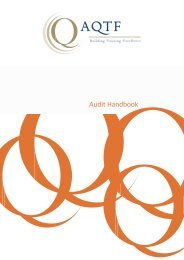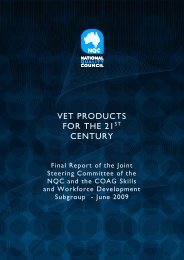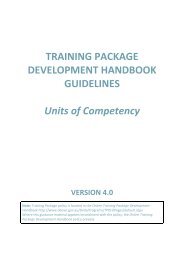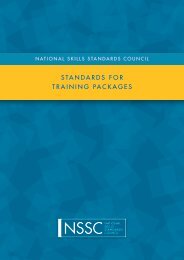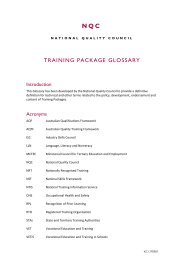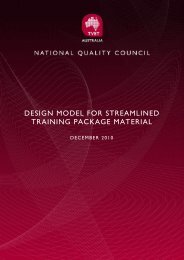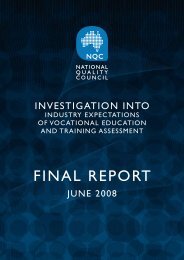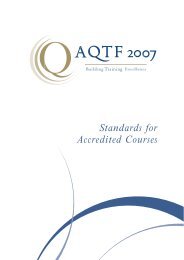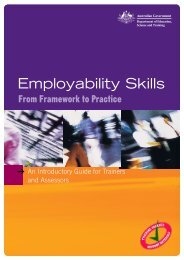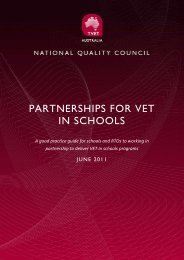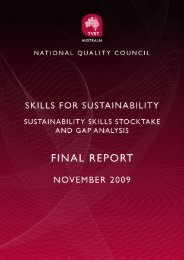Training package development handbook guidelines
Training package development handbook guidelines
Training package development handbook guidelines
Create successful ePaper yourself
Turn your PDF publications into a flip-book with our unique Google optimized e-Paper software.
(b)<br />
(c)<br />
(d)<br />
that the amendment allows ISCs to transition qualifications to the new packaging rules for<br />
flexibility, and the embedding of green skills, where the qualification outcomes and<br />
structure have not substantially changed and where the ISC determines that there is no<br />
need to seek industry validation via a full endorsement process;<br />
that the proposed amendment to the <strong>Training</strong> Package Development and Endorsement<br />
Process 2008 apply until 31 December 2010 to align with the end date for transition to<br />
new packaging rules for flexibility and embedding of green skills in <strong>Training</strong> Packages;<br />
that the following communication processes will be required to support the amendment:<br />
i. ISCs notify and explain ISC upgrades to State <strong>Training</strong> Authorities and the NQC<br />
ii. ISCs update the <strong>Training</strong> Package version and the version modification history to<br />
explain in detail the particulars of the change<br />
iii. ISCs publish the change to NTIS.<br />
5. Contextualisation of qualifications<br />
Contextualisation of qualifications allows substitution of some units of competency in qualifications<br />
where this is consistent with the described work outcome and outlined in the qualification’s<br />
packaging rules. The substitution may be with units <strong>package</strong>d in other qualifications in the same<br />
<strong>Training</strong> Package, or from other endorsed <strong>Training</strong> Packages; such contextualisation must not distort<br />
the qualification purpose or its alignment to the AQF.<br />
Advice on allowable contextualisation of qualifications must be included in the <strong>Training</strong> Package. The<br />
advice must clearly set out the boundaries to contextualisation to ensure users can readily<br />
determine what is acceptable to industry. The advice could be developed around scenarios or<br />
examples of typical job roles, or could be a list of what is allowable and what is not (‘do’s and<br />
don’ts’), and could include the:<br />
• codes and titles of units of competency that can be substituted for specified units in the <strong>Training</strong><br />
Package<br />
• relevant <strong>Training</strong> Packages from which the units can be drawn<br />
• AQF qualifications in which any specified units are used in the source <strong>Training</strong> Package.<br />
6. Credit transfer and articulation<br />
In determining packaging rules, developers should attempt to optimise opportunities for credit<br />
transfer arrangements between VET and higher education qualifications where applicable, while also<br />
meeting industry needs.<br />
7. Employability Skills Summaries<br />
An Employability Skills Summary describes Employability Skills requirements at a qualification level.<br />
These summaries are the minimum, mandatory Employability Skills requirement for the endorsed<br />
components of <strong>Training</strong> Packages—they summarise the Employability Skills that are embedded in<br />
the units that make up the qualification.<br />
The Employability Skills Summaries provide a lens through which to view these skills at the<br />
qualification level; they capture the key aspects or facets of the Employability Skills important to the<br />
GuidelinesQualFrameworks_V3_June 2010 V3 June 2010 Page 12 of 28



